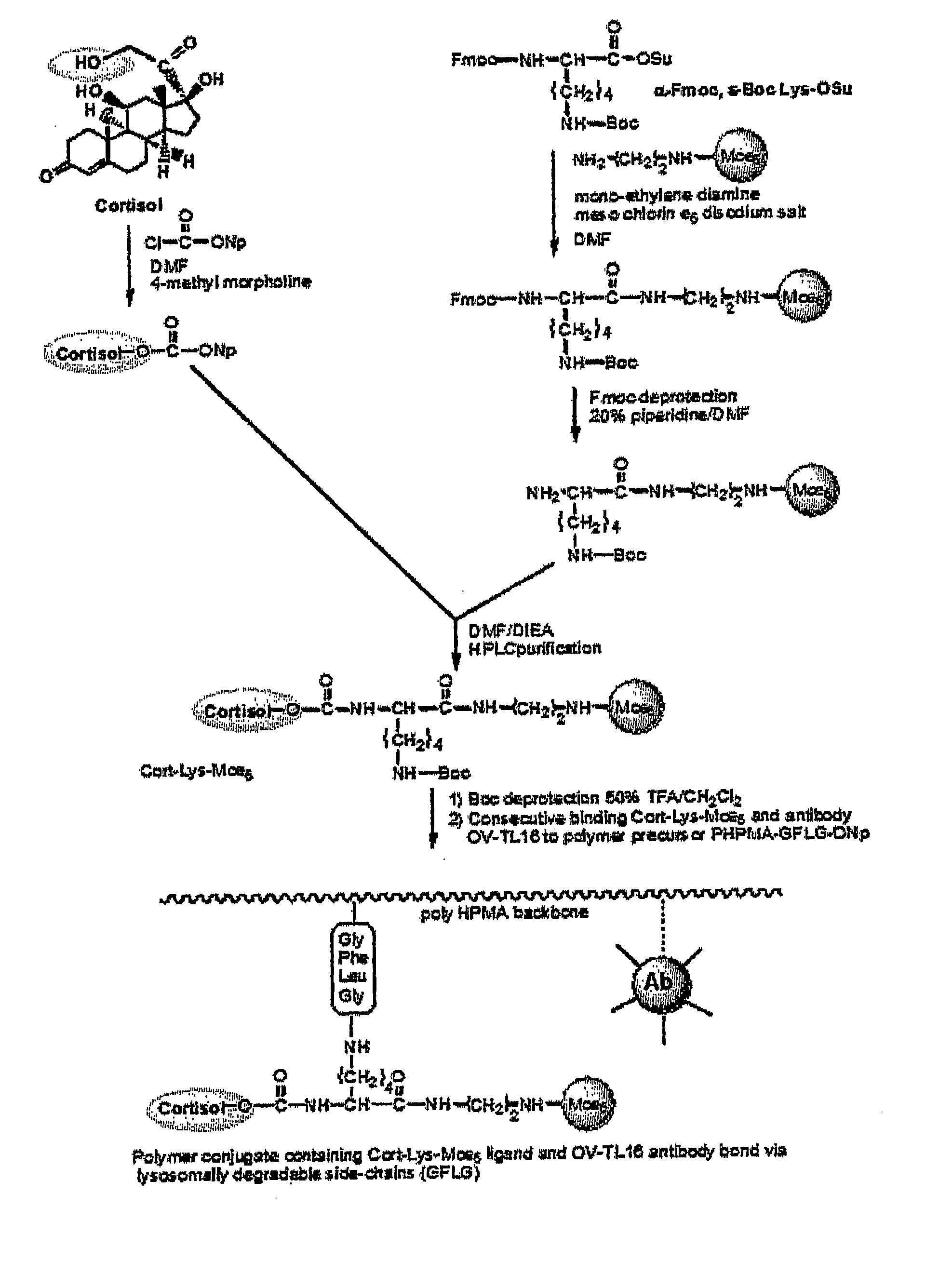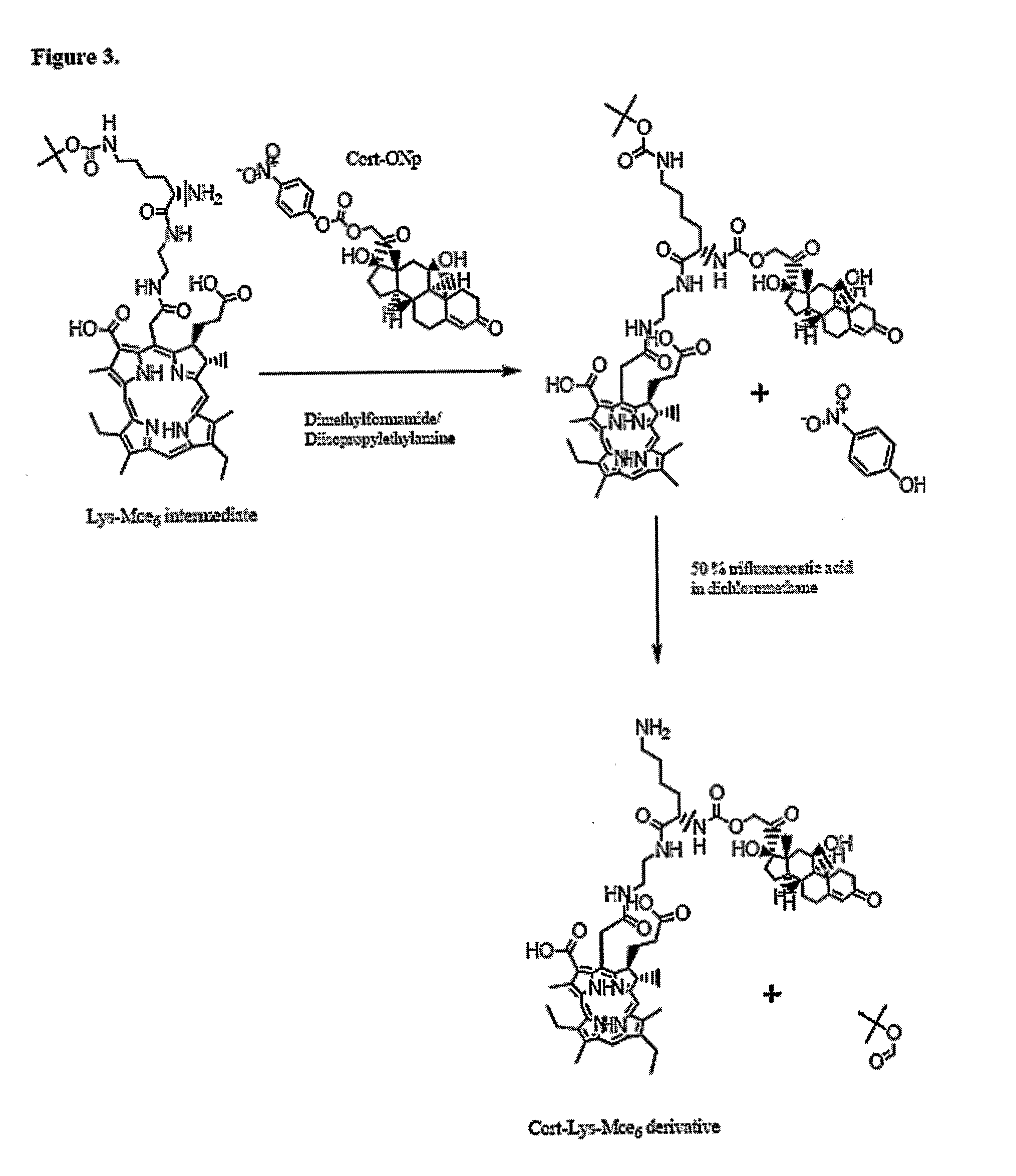Combined Active and Passive Targeting of Biologically Active Agents
a biologically active agent and target technology, applied in the field of biotechnology, can solve the problems of unexpected high biological activity using this approach, and achieve the effects of enhancing tumor uptake, reducing doses, and improving therapeutic efficacy
- Summary
- Abstract
- Description
- Claims
- Application Information
AI Technical Summary
Benefits of technology
Problems solved by technology
Method used
Image
Examples
example i
Synthesis of Cort-Lys-Mce6
[0046] The example involves the synthesis of a double-targeted system for the nuclear targeting of Mce6 (FIG. 3) and illustrates the synthetic process involved in the synthesis of Cortisol-Lys-Mce6. Cortisol was acylated with twice molar excess of 4-nitrophenyl chloroformate in methylene chloride and thrice molar excess of 4-methyl morpholine to form Cort-ONp (Cortisol-C17-4-nitrophenyl ester) (carbonic acid 2-(11,17-dihydroxy-10,13-dimethyl-3-oxo-2,3,6,7,8,9,10,11,12,13,14,15,16,17-tetradecahydro-1H-cyclopenta[a]phenanthren-17-yl)-2-oxo-ethyl ester 4-nitro-phenyl ester) (FIG. 4). The reaction mixture was washed sequentially with 1 N hydrochloric acid, concentrated solution of sodium bicarbonate and concentrated solution of sodium chloride. The solution was then dried over sodium sulfate and crystallized to obtain the product (Cort-ONp).
[0047] Mce6 was reacted with N-alpha-Fmoc, N-ε-Boc-Lysine N-hydroxysuccinimide ester(6-tert-Butoxycarbonylamino-2-(9H-fl...
example ii
Synthesis of P-GFLG-Cort-Lys-Mce6
[0048] The polymer precursor P-GFLG-ONp (P=PHPMA backbone), was prepared by radical precipitation copolymerization of HPMA (2-hydroxypropylmethacrylamide) and N-methacryloylglycylphenylalanylleucylglycyl p-nitrophenyl ester in acetone in the presence of 2,2′-azobisisobutyronitrile (AIBN). Next, the binding of Cort-Lys-Mce6 to P-GFLG-ONp was performed in DMF (FIG. 7). Unreacted 4-nitrophenoxy group was eliminated by the addition of 1-amino-2-propanol. The product was isolated by precipitation into acetone and purified by chromatography in methanol. The polymer was then dialyzed against deionized water and isolated by freeze-drying.
example iii
Synthesis of Control Polymers
[0049] The control polymer P-GFLG-Mce6 was synthesized by the aminolysis of P-GFLG-ONp with free Mce6 in DMF followed by the elimination of unreacted p-nitrophenoxy group with 1-amino-2-propanol. The polymer was then precipitated in acetone and purified by column chromatography in methanol. Dialysis was then performed in deionized water followed by lyophilization.
PUM
| Property | Measurement | Unit |
|---|---|---|
| Mw | aaaaa | aaaaa |
| polydispersity | aaaaa | aaaaa |
| Mw/Mn | aaaaa | aaaaa |
Abstract
Description
Claims
Application Information
 Login to View More
Login to View More - R&D
- Intellectual Property
- Life Sciences
- Materials
- Tech Scout
- Unparalleled Data Quality
- Higher Quality Content
- 60% Fewer Hallucinations
Browse by: Latest US Patents, China's latest patents, Technical Efficacy Thesaurus, Application Domain, Technology Topic, Popular Technical Reports.
© 2025 PatSnap. All rights reserved.Legal|Privacy policy|Modern Slavery Act Transparency Statement|Sitemap|About US| Contact US: help@patsnap.com



